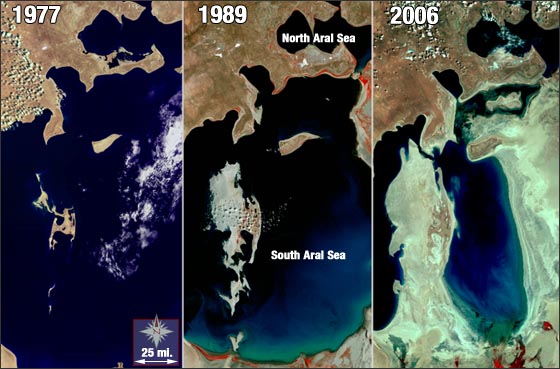The Aral Sea is one of the largest saline lakes in the world, and a fascinating part of the geography of Central Asia. Because the USSR diverted the rivers that feed it in order to support massive desert irrigation projects, the Sea has been drying up. It’s pretty ugly:

T The primary effect of the Aral Sea desiccation has been the significant loss of water in the sea. The water level has dropped approximately 23 meters since the onset of its primary sources of water being diverted (Zavialov 2005). Although the water level has fluctuated up to a few meters in the past due to natural variability in the water flow from the rivers, by 1970, the water loss exceeded the limit of natural water level variation that has occurred in the past.
Watch it happen in timelapse:
In case you didn’t already know that everything is connected to everything else, there’s this:
…the shrinking sea and salty dust storms have already changed the climate in the region to the point of an unlikely return to the stability once present in the area. With the shrinking sea there is not enough surface area to disrupt frigid north winds. Nor does the sea contribute the moisture it once did to the snowfall in mountains of neighboring and more distant regions. In addition to the temperature steadily increasing the dust and salt storms are coating the mountain glaciers nearby and causing a decrease in the overall volume of ice. The degree of melting is over twelve times the rate of the pre-cotton growing era and as there is less moisture in the air to replace the dissipating snow the glaciers continues to diminish. As the glaciers continue to melt the weather will become less likely to experience the sort of seasonal stability it once did.
We have just looked at the intricate behaviors of climate systems in the Aral region, including their interactions and the chain reactions that we call positive feedbacks. Not only did they reshape the landscape and natural balance of the region, they also affected dramatically the populations that live or used to live in this area. Public health, access to drinkable water, migrations due to changing landscape and consequences of vanishing wildlife are all matters that turn out to rely on stable climatic and hydrologic conditions.
That part of Central Asia is home to some of the world’s most fascinating music: